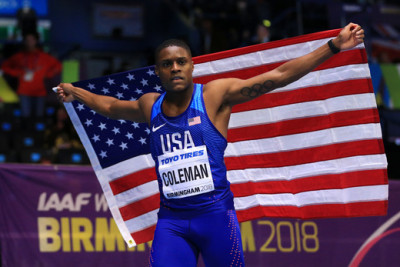Christian Coleman vs. Marcell Jacobs at World Indoors Is the Race Track & Field Needs & Has Been Waiting For
By Jonathan Gault
March 15, 2022
In the short sprints, a truly great race requires a backstory. Great performances can stand on their own. But for a great race in an event that lasts 10 seconds or less, there needs to be some sort of buildup.
The greatest 100-meter race of the 2010s was the 2015 men’s World Championship final in Beijing. And while the race itself was dramatic, Justin Gatlin breaking form 10 meters from the finish line as Usain Bolt edged him by a hundredth of a second, it is remembered just as much for what preceded it. Bolt, cast as the white knight trying to preserve his win streak in global finals against Gatlin, trying to win his first world outdoor title since returning from a four-year doping suspension. Bolt and Gatlin avoiding each other for two years until the final. Bolt entering the race as an underdog (yes, this was true) for the first time since setting those world records on the Bird’s Nest track seven years earlier. The race lived up to the hype, but without the backstory, it doesn’t go down as one of the greatest races in the history of sprinting.
That’s just the way things are in the sprints. There are no tactics to analyze, and ten seconds — six, in the case of the 60m — is rarely long enough for a rich story to unfold. Some hype is necessary.
The men’s 60 meters at this weekend’s World Athletics Indoor Championships in Belgrade, Serbia, should be accompanied by a great deal of (justified) hype. For many of the world’s top sprinters, World Indoors is an afterthought. Bolt never ran it. In fact, until this year no reigning men’s Olympic 100-meter champion had ever run World Indoors. Earning the title of World’s Fastest Man at the Olympics typically requires (or bestows) a healthy amount of ego. Why rush back to top fitness and threaten that aura of invincibility by running an off event at World Indoors when you sit back and wait for the appearance checks to start rolling in outdoors?
But now, for the first time in 13 years, the reigning Olympic champion is not Usain Bolt, and things have changed. His successor, Italy’s Marcell Jacobs, grew up competing indoors during the winter and his 6.47 win in the 60 at last year’s European Indoor Championships in Poland was the first hint he could do some damage at the Olympics that summer. After skipping the remainder of the 2021 outdoor season following double golds in the 100 and 4×100 relay in Tokyo, Jacobs has run a full indoor campaign with four wins from five starts in the 60 meters, the sole blemish a false start* in his most recent race in Belgrade on March 7. He will run the event at World Indoors.
*Between the men’s and women’s 60m finals in Belgrade, four separate athletes were DQ’d for false starts. After lane violations marred the last World Indoor Championships in Birmingham, let’s hope there are no more DQ controversies this weekend.
And as if Jacobs was not a big enough draw by himself, he will square off in Belgrade against the reigning World Outdoor 100m champion, American Christian Coleman.
That is exciting not only because Coleman is arguably the greatest 60-meter runner the world has ever seen (he owns the top three performances in history and has not lost a race at the distance in over six years), but because Jacobs-Coleman is the showdown the track world has been waiting to see. Coleman, in case you’ve been living under a rock, was the 2021 Olympic favorite before he was suspended for 18 months for missing three drug tests. “Would Christian Coleman have won Olympic gold in Tokyo?” is a question that will remain forever unanswered, but “Can Christian Coleman beat Marcell Jacobs at a World Championships?” will have a definitive response by Saturday night.
Plus this is only the second time the reigning world 100m champ has shown up at World Indoors (Maurice Greene also did it in 1999).
This being track & field, their showdown will be accompanied by a hint of skepticism. Coleman, though he has never tested positive and has always denied using performance-enhancing drugs, did serve that whereabouts ban. Meanwhile, almost every non-Italian article about Jacobs since his Olympic win has noted his extraordinary improvement last year, when he went from never breaking 10 seconds before last year to running 9.80 in the Olympic final at age 26. Jacobs’ relationship with Giacomo Spazzini, his onetime nutritional adviser, drew scrutiny after Spazzini was implicated in a government investigation into steroids, but Spazzini was exonerated in January.
The 2022 season has been building toward this showdown, and the performances of both men have only heightened the expectations in Belgrade, as neither has been beaten in a 60 this year. Coleman enters as the favorite. At the Millrose Games on January 29, he hadn’t run a real race in almost two years (I’m ignoring his 300m tuneup two weeks earlier) and still took down a world class-field including World Indoor medalists Trayvon Bromell and Ronnie Baker in 6.49. At USAs, Coleman was faster, cruising to 6.45 — the best time in the world this year. He may not be back to his 6.34 world record form yet, but given the long layoff, expect him to be even better in Belgrade.
Jacobs has also looked good, but in nine races this year (five prelims, four finals), his fastest time is 6.49. That could well go lower this weekend, as Jacobs has shown a knack for summoning his best when it matters most — his 6.47 at Euro Indoors last year was a personal best, and he ran pbs in all three rounds of the Olympics. But his ceiling in the 60 is lower than Coleman’s, who is one of the best starters in history, and the fastest to ever run the event. When both are fit and healthy (as is the case now), Coleman has the clear edge.
American Marvin Bracy has a shot of breaking up the two heavyweights — he earned silver in this meet in 2014 and tied his pb of 6.48 at USAs — but that’s about it, barring a false start. No one else in the field has ever broken 6.50.
Now it’s worth keeping things in perspective. To use a tennis analogy, World Indoors is the Australian Open and World Outdoors is Wimbledon. Both are important, but we all know which one you’d rather win.
Still, if World Indoors can be the Australian Open, that’s a good thing. Because if we’re being honest, World Indoors isn’t even that right now (Trayvon Bromell and Andre De Grasse would not blow off the Australian Open if they were tennis players). Tennis has four events every year where every pro shows up and the outcome truly matters. Track & field has one event like that per year — and once every four years, it has none! So when stars like Jacobs and Coleman (and Jakob Ingebrigtsen and Grant Holloway and Mondo Duplantis), they’re sending a message: World Indoors matters too.
Let’s not lose sight of the big picture here. For the first time ever, the Olympic 100-meter champion is racing at World Indoors, and he’s facing the World Outdoor 100-meter champion who didn’t get to run the Olympics. There is a gold medal on the line. It’s the race of the championships. Even if it will barely last six seconds.




